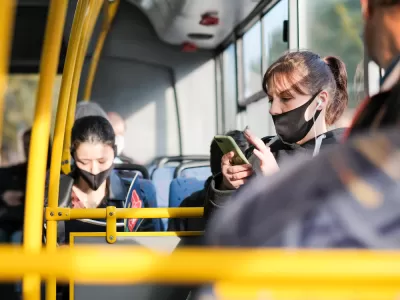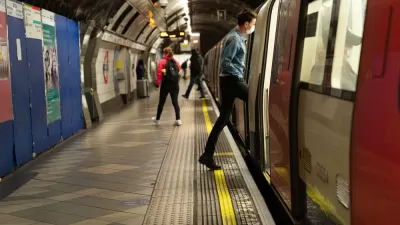Why is it hard for transit agencies to enforce pro-mask rules?

A few weeks ago, a certain relative of mine (who I shall call "R") was in a difficult situation. She got a part-time job, which required her to take a commuter train to Newark, New Jersey and a bus through the city of Newark to get to the job. She was not afraid to travel on the commuter train; it wasn’t very crowded, and people were generally wearing masks to reduce the risk of COVID-19 infection. But the bus was different; even though it was not enormously crowded, people were not always wearing masks, or were wearing them improperly, or were engaging in the sort of long cell phone conversations that are more likely to spread the virus. As a result, she quit the job.
Shortly afterwards, R asked me why the transit agency was not more aggressive about requiring riders to wear masks.* At first glance, this seems like an easy decision: if people are afraid to ride the bus because of unmasked riders, they won't. So why might a driver not enforce this rule?
First of all, agency every minute the bus driver spends arguing with riders is a minute more of delay that inconveniences people waiting for the bus. So the driver has to weigh two evils: the risk of infection from unmasked riders and the less dangerous, but more frequent, harm from sluggish buses.
Second, because talking loudly spreads the virus, arguing with riders also creates a public health risk: an argument means that a possibly-infected rider might talk even more and spread even more risk, and that a possibly-infected bus driver might talk and do the same. And since bus drivers might get closer to the rider in order to argue or to physically eject the rider, this too increases the risk of infection (because being ten feet from the rider is less risky than being two feet from the rider).
Third, if the rider is extremely unwilling to comply the driver might call the police to eject the rider—but this creates more risk in two ways. First, if the rider is infected the police might get infected as well. Second, if interactions become violent, that might cause someone to visit an emergency room, overburdening the health care system or even infecting doctors and nurses. Occasionally, violent interactions between police and citizens lead to riots, creating even more harm to a wide variety of persons.
Like many other rules, the "masks on buses" rule works only work if almost everyone is willing to comply without coercion. Once a critical mass of people decide to violate the rules, enforcement becomes extremely costly.
*One alternative might be to prominently post "how to wear a mask" notices. Although this would probably increase compliance with pro-mask rules, I suspect it would not lead to 100% compliance.

Planetizen Federal Action Tracker
A weekly monitor of how Trump’s orders and actions are impacting planners and planning in America.

Map: Where Senate Republicans Want to Sell Your Public Lands
For public land advocates, the Senate Republicans’ proposal to sell millions of acres of public land in the West is “the biggest fight of their careers.”

Restaurant Patios Were a Pandemic Win — Why Were They so Hard to Keep?
Social distancing requirements and changes in travel patterns prompted cities to pilot new uses for street and sidewalk space. Then it got complicated.

Platform Pilsner: Vancouver Transit Agency Releases... a Beer?
TransLink will receive a portion of every sale of the four-pack.

Toronto Weighs Cheaper Transit, Parking Hikes for Major Events
Special event rates would take effect during large festivals, sports games and concerts to ‘discourage driving, manage congestion and free up space for transit.”

Berlin to Consider Car-Free Zone Larger Than Manhattan
The area bound by the 22-mile Ringbahn would still allow 12 uses of a private automobile per year per person, and several other exemptions.
Urban Design for Planners 1: Software Tools
This six-course series explores essential urban design concepts using open source software and equips planners with the tools they need to participate fully in the urban design process.
Planning for Universal Design
Learn the tools for implementing Universal Design in planning regulations.
Heyer Gruel & Associates PA
JM Goldson LLC
Custer County Colorado
City of Camden Redevelopment Agency
City of Astoria
Transportation Research & Education Center (TREC) at Portland State University
Camden Redevelopment Agency
City of Claremont
Municipality of Princeton (NJ)





























